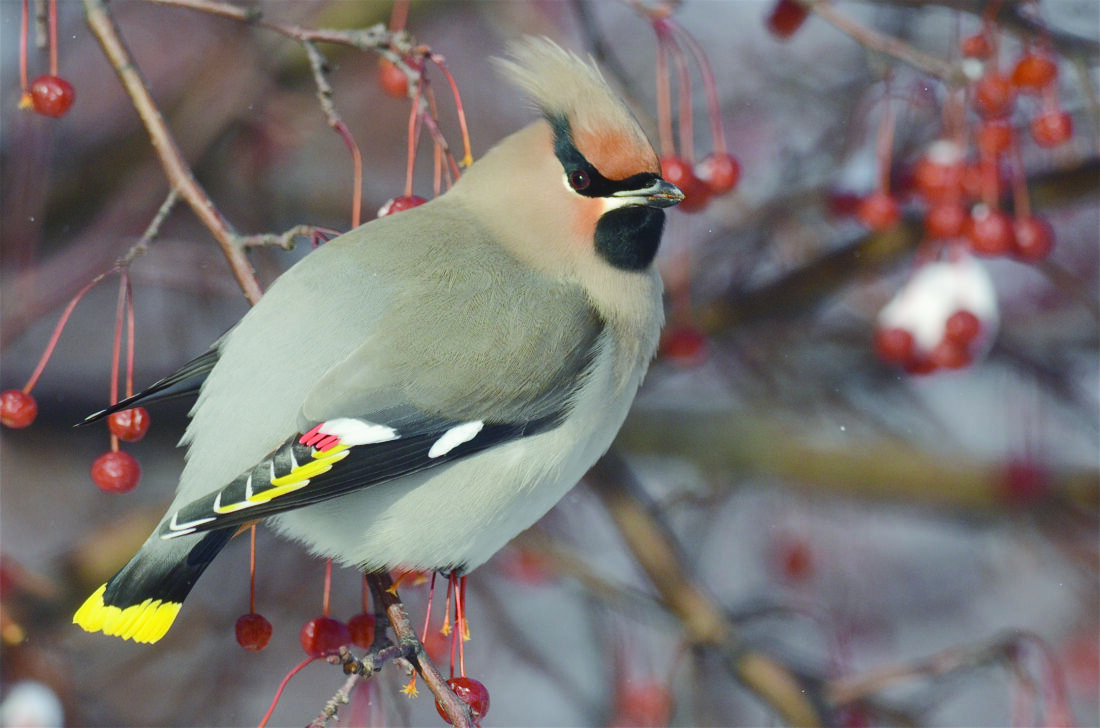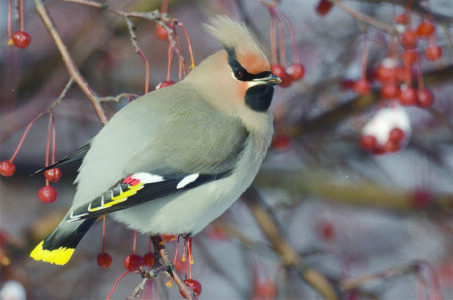What’s Flying: Some of the best birding of the year

A bohemian waxwing looks on. (Scot Stewart photo)
“It is the life of the crystal, the architect of the flake, the fire of the frost, the soul of the sunbeam. This crisp winter air is full of it.” – John Burroughs
Winter has finally opened the door fully and made its entrance into the Upper Peninsula. There is something about a foot and a half of snow and freezing north winds to convince most the times they are a changin.’ Those winds convinced a number of species of birds to head into the Upper Peninsula too making it a great week for new and vagrant species to show up here.
Each autumn an unofficial watch begins along the Lake Superior shoreline in Marquette, at Whitefish Point, and other key points along the water’s edges for newly arrived snowy owls. Research this past summer on the tundra of Canada indicated substantial lemming populations, snowy owls’ important summer food for raising larger broods of young. Those large populations of young birds lead to diminished lemming populations forcing many of the owls to move southward during winter months.
Last Saturday the first snowy owl sighting was reported on Lakeshore Blvd. near Wright Street in Marquette. There were sighting reports two days later suggesting up to four owls were resting during the daytime between the Marquette Coast Guard Station and Presque Isle, and daily reports through Tuesday. Because the owls look for daytime roosts away from the shore or in semi-concealed locations out of the view of crows and jays, they may not reappear to hunt until dusk or later and avoid being seen by humans.
On the same day the first snowy was seen in Marquette two appeared at Whitefish Point. There has been a snowy owl sighting about every other day since last Saturday at the Point too. These birds will probably continue south and may continue to open fields near Rudyard and Pickford or continue on to the Lower Peninsula. Opportunistic feeders, they hunt cottontail rabbits, mice and voles, ducks like buffleheads, common goldeneyes (just recently arrived in the area too), and even larger birds like mergansers.

STEWART
The latest change in weather has also seen the arrival of flocks of bohemian waxwings in Marquette with a flock of 50 seen in Marquette Township last Tuesday and a second flock of nineteen in Harvey the following day. They will be looking for mountain ash fruit and smaller crab apples. A check around Marquette this week found crab apple trees in a variety of stages. Some are bare – two robins were found in different parts of town feeding in nearly bare trees. This is particularly true for many of the crab apple trees with smaller fruits. Some crab apple trees still are holding onto most of their leaves making it difficult to see any birds in the trees. Several crabs at Presque Isle currently have a fair amount of fruit and nearly all their leaves. Because there are still a fair number of crab apple trees with fruit some waxwing may stick around for a while.
Another species of winter vagrant just moving into the area in larger numbers is the pine grosbeaks. They are also crab apple eaters, but look for larger fruits than the waxwings, and not just for the fruit. They often bite into the apples and looking more for the seeds and will eat some of the fruit too but often leave half the fruit on the tree when they are done.
One curious event occurred with a male pine grosbeak in Marquette this past week. It was feeding on black-oil sunflower seeds at a home when it and a small group of mourning doves were flushed, possibly by a sharp-shinned hawk. The grosbeak flew into a window marked with a falcon silhouette. The dazed bird was taken inside and placed in a box with padding on the bottom. After about four hours it began flapping its wings and was taken back outside where it quickly flew away. What made the return most remarkable was its missing tail. It was not certain if the bird lost it before or just prior to its accident. It did return the next day to feed again at the feeders.
Several flocks of snow buntings have also nestled down in the Marquette area. One flock of about two dozen has been seen several times in the weedy portions of the fields around the Superior Dome. Remarkably, they can go literally unseen in the well-mowed fields until they flap up to move at another nearby spot looking for weed seeds. Then their bright white tail and wing patches betray their location. Often determined to continue feeding, when flushed they have often circled around the field, stopping sometimes to grit in a nearby parking to swallow some small bits of gravel to help grind the seeds they eat in their gizzards, before turning to another part of the field to continue foraging.
Flocks of American goldfinches have descended into birches across the U.P. to feed on those seeds. On Presque Isle several large flocks have been seen just south of the cove area, a traditional fall feeding site. Two other notable vagrants have had birders buzzing in Marquette this week too. A western grebe has continued now for more than a week in the Lower Harbor of Marquette, and on Wednesday, a harlequin duck was spotted in the Upper Harbor of Marquette near the end of the ore dock. Most often seen in the western states, they occasionally wander eastward into the Great Lakes and sometimes stop in the Marquette area. Winter is bringing some of the best birding of the year.
- A bohemian waxwing looks on. (Scot Stewart photo)
- STEWART



